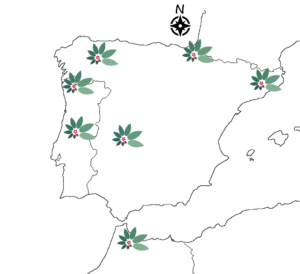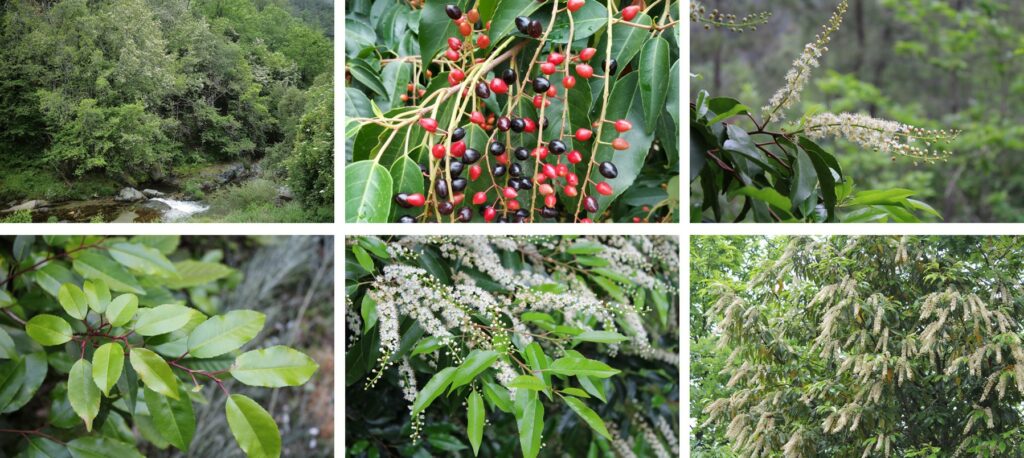Portuguese Laurel Woodland
At the end of the Tertiary (5 – 3 Ma) the climate of Southern Europe was warmer and more humid than today and without a pronounced dry season. The dominant forest was Laurissilva, made up of species of evergreen woody trees, with large, wide, glossy and leathery leaves. The gradual cooling at the end of the Tertiary, the sharp decrease in precipitation and the Quaternary glaciations determined the decline and almost disappearance of this forest. However, traces of those relict forests remained confined in enclaves protected from the dry cold and have managed to survive until the present. The portuguese laurel (Prunus lusitanica subsp. lusitanica) was one of the tree species present in the Laurissilva forests and, currently, has a scattered distribution limited to the Iberian Peninsula, Northern Morocco and the French Pyrenees, considered in Danger of Extinction by the IUCN.

Geographic distribution map of the Portuguese Laurel (Prunus lusitanica subsp. lusitanica) in the Iberian Peninsula
The territory affected by the valleys of the Alvoco and Loriga rivers, tributaries of the Alva river, is, without a doubt, one of the main areas of refuge for this unique tree of Portuguese flora. Not neglecting the iconic Mata da Margaraça in the municipality of Arganil. In the parishes of Alvoco da Serra, Teixeira and in the União de Freguesias de Vide and Cabeça, in the municipality of Seia, the cherries find peculiar conditions for their persistence and survival. The pronounced notch of the valleys and the oceanic influence have a preponderant effect on climate modeling, allowing the existence of high levels of environmental humidity and less pronounced thermal contrasts. Under these conditions, the azereiro finds its main areas of occurrence in numerous ravines, streams and banks of watercourses, showing a clear preference for places with a high water table, protected from the most intense cold and exposed to the N/NW quadrant.
In this region, the holm oak nuclei are distributed over a wide altitudinal range for the species, occupying different climatic environments. In the deep and embedded shale valleys, located in areas with greater Mediterranean influence, it shares its habitat with leaf litter, alder, ash, strawberry tree, holly, laurel and lentisk. In the past, it was part of the list of mixed oak and cork oak forests in this region. Perhaps being dominant in particular ecological niches with high water table and rupicolous character. In a less common context, and revealing the plasticity of the species, it appears associated with black oak, yew and birch at around 1300 m altitude, the highest elevation recorded in the Iberian Peninsula, in an area with greater Atlantic influence. and granite substrate. This scenario reminds and justifies that in the recent past the distribution of walnut trees and hardwood forests with evergreen shrubs would have been much wider.

The Portuguese Laurel are forest formations, very similar to the Laurissilva type forests, present in the Iberian island territories. More than half of the entire Iberian population is concentrated in areas of rugged relief in the mountains of the central interior of Portugal, particularly in the Açor, Estrela, Lousã and Alvelos mountains. In the landscape of these mountains, marked by the presence of extensive areas of pine forest and acacia, they constitute a living testimony to a unique and relict type of primitive vegetation cover and one of the last strongholds for this species. The massive pine plantations that began at the end of the 19th century and continued until the 80s of the 20th century, the subsequent advance of eucalyptus reduced and pushed back the hardwood forests to tiny areas. Since the mid-20th century, a period that coincides with the depopulation of this territory, this landscape has been regularly and recurrently ravaged by large and increasingly destructive fires. In this context, we are also witnessing the uncontrolled entry and proliferation of exotic species such as the mimosa and, more recently, the spicy haquea.
The European Union recognized the importance of preserving Portuguese Laurel comnnunities and integrated them into a habitat of Community Importance, a priority for conservation, in the Habitats Directive (92/43/EEC). Therefore, LIFE-Relict aims to reverse this situation. Control and, if possible, eradicate exotic and invasive species, reduce the dense bush load of broom and heather and manage the pine forest in a sustainable way. In short, control the threats, return native forests to this territory through environmental restoration with native trees such as oaks, cherry trees, cork oaks and shrubs such as foliage, arbutus and aderno. Recreate and naturalize the landscape that in distant times covered the mountains of Central Portugal, authentic reserves of biodiversity. A forest adapted to local soil and climate conditions and that meets the desires and security of these populations.









